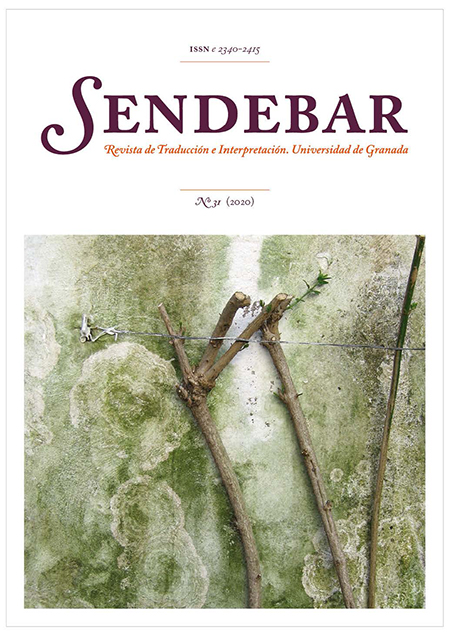La traducción audiovisual en Venezuela: aspectos históricos, técnicos y profesionales
DOI:
https://doi.org/10.30827/sendebar.v31i0.11802Palabras clave:
traducción audiovisual, doblaje, subtitulación, Venezuela, Hispanoamérica, español neutro, historia de la traducciónResumen
La investigación sobre traducción audiovisual (TAV) ha estado hasta ahora restringida básicamente al contexto europeo, ignorando casi por completo el ámbito hispanoamericano. Además, tampoco se han estudiado el trasfondo y los factores que influyeron en la aparición y el desarrollo de las modalidades de traducción audiovisual en América Latina. El presente artículo muestra un recorrido por los aspectos históricos, sociales, políticos, técnicos y profesionales que han ido conformando hasta la actualidad la traducción audiovisual en Venezuela, país clave en la evolución de la TAV en Hispanoamérica y en la influencia del denominado “español neutro”. La investigación se basa, en parte, en los testimonios nucleares de algunos de los principales traductores, correctores y gestores de la TAV en Venezuela.
Descargas
Citas
“Argentine Film Industry”, Variety, 30 de agosto de 1944, p. 15.
“Argentina Sends Up Big Barrage on Dubbed Pix”, Variety, 24 de enero de 1945, p. 11.
Ávila Bello, Àlex (1997). La historia del doblaje cinematográfico. Barcelona: CIMS.
Cervantes, Instituto (2019). “577 millones de personas hablan español, el 7,6 de la población mundial”. Cervantes.es. https://www.cervantes.es/sobre_instituto_cervantes/prensa/2018/noticias/np_presentacion-anuario.htm. [Consulta: 20 noviembre 2019].
Chaume, Frederic (2019). “Audiovisual translation in the age of digital transformation”, en Ranzato, Irene y Zanotti, Serenella (eds.) Reassesing Dubbing. Historical approaches and current trends, Amsterdam/Philadelphia: John Benjamins Publishing Company.
Chaume, Frederic (2012). Audiovisual Translation: Dubbing. Manchester/Kinderhook: St. Jerome Publishing.
De Gabriel, Narciso (1997). “Alfabetización y escolarización en España”, Revista de Educación, nº 314, (217-243).
Delabastita, Dirk y Grutman, Rainier (2005). “Fictional representations of multilingualism and translation”. Linguistica Antverpiensia, new series, 4. 11–34, p. 16.
“Doblaje de Películas. Una gran noticia”, Mi Film, Caracas, n° 102, 28 de septiembre de 1944, p. 5.
“El cine hablado en español”, El Nacional, Caracas, 22 de marzo de 1945, p. 13.
Fuentes-Luque, Adrián (2019a). “An Approach to Audio-Visual Translation and the Film Industry in Spain and Latin America”. Bulletin of Spanish Studies, Volume 96, Issue 5, (815-834).
Fuentes-Luque, Adrián (2019b). “Silence, sound, accents: early film translation in the Spanish-speaking world”, en O’Sullivan, Carol y Cornu, Jean-François (eds.) The Translation of Films, 1900-1950, London: Oxford University Press.
Fuentes-Luque, Adrián (2012). “La historia de la traducción audiovisual en Latinoamérica: aproximación a su investigación”, en Francisco Lafarga y Luis Pegenaute (eds.) Lengua, cultura y política en la Historia de la Traducción en Hispanoamérica. Vigo: Academia del Hispanismo. (77-82).
Glancy, H. Mark (1999). Hollywood’s foreign markets. When Hollywood Loved Britain. Manchester: Manchester University Press.
Goldschlager, Daniel (2019). Entrevista personal.
Gunckel, Colin (2008). “The war of the accents: Spanish language Hollywood films in Mexican Los Angeles”. Film History: An International Journal, Vol. 20, No. 3, (325–343).
HBO Latin America (2014). Guía de estilo de subtitulación al español. Caracas: HBO.
Ivarsson, Jan (1992). Subtitling for the Media. Stockholm: Transedit.
Ivarsson, Jan, y Carroll, Mary (1998). Subtitling. Simrishamn: TransEdit.
Izard, Natàlia (1992). La traducció cinematogràfica. Barcelona: Generalitat de Catalunya, Centre d’Investigació de la Comunicació.
Jarvinen, Lisa (2012). The Rise of Spanish-Language Filmmaking. New Brunswick, N.J.: Rutgers University Press.
Jiménez, Renzo (2008). Propuesta de nacionalización del doblaje en Venezuela. http://blogderenzojimenez.blogspot.com/2008/11/propuesta-de-nacionalizacion-del.html [Consulta: 3 enero 2020].
Lee, Kevin (2008). “The Little State Department: Hollywood and the MPAA’s Influence on U.S. Trade Relations”, Northwestern Journal of International Law and Business, Volume 28, Issue 2, (371-398).
“Mexican Unions Threat”, Variety, 12 de julio de 1944, p. 3.
Navitski, Rielle (2014). “Reconsidering the Archive: Digitization and Latin American Film Historiography”, Cinema Journal, Vol. 54, No. 1, (121-128).
Nouel, Jeannette (2019). Entrevista personal.
Roberts, Luis (2019). Entrevista personal.
Rodríguez Yárnoz, Carlota (2019). Entrevista personal.
“Rush for Sound Movies”, The New York Times, Nueva York, 6 de abril de 1929, p. 26.
“Tendremos películas norteamericanas habladas en español”, El Nacional, Caracas, 2 de diciembre de 1944, p. 8.
Usabel, Gaizka S. de (1982). The High Noon of American Films in Latin America. Ann Arbor, Mich.: UMI Research Press. p. 127.
Descargas
Publicado
Cómo citar
Número
Sección
Licencia
Terminos de Licencia Sendebar.

















